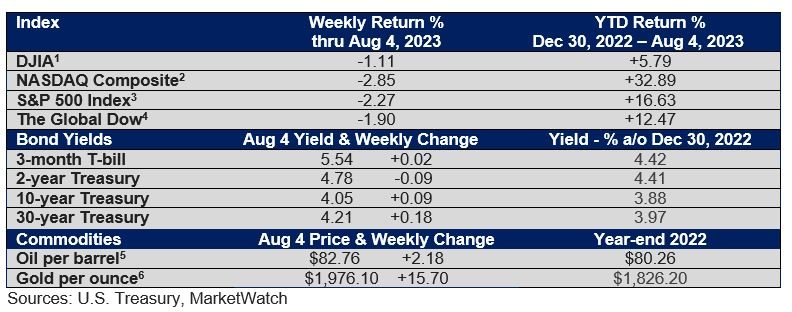Fitch Strips USA of Triple-A Credit Rating
Fitch Ratings downgraded U.S. government debt last week by one notch from its prized top rating of ‘AAA’ to ‘AA+.’ Fitch said its decision “reflects the expected fiscal deterioration over the next three years, a high and growing general government debt burden,” and repeated political brinkmanship surrounding the debt ceiling debates.
The decision didn’t come as a surprise since Fitch had warned in May, when lawmakers were battling over the nation’s debt ceiling, that the ‘AAA’ rating was under the microscope.
U.S. debt was last downgraded in 2011 when Standard & Poor’s cut its triple-A rating to ‘AA+.’ Only Moody’s maintains its triple-A rating on U.S. debt.
To some extent, it’s difficult to completely disregard the reasoning behind the downgrade. The federal debt as a percent of Gross Domestic Product (GDP) has more than tripled over the last 40 years.
Due to higher interest rates, interest payments on the debt are nearing an annualized pace of $1 trillion, up from $530 billion two years ago, according to Bloomberg.
Despite low unemployment and an expanding economy, Fitch projects that this year’s annual deficit will rise to 6.3% of GDP, up from 3.7% in 2022.
There is also a concern over the increase in Treasury debt that will be issued over the next few months, which could hang over the Treasury market, according to Bloomberg.
There was a modest selloff in stocks and an uptick in Treasury yields in the wake of the news. Yet, the downgrade was not without criticism from some "prominent" economists. To begin with, there have been no significant economic changes in the period leading up to the decision. The downgrade was not unexpected, and it is unlikely to have any impact on the use of Treasuries as a fundamental asset in the U.S. and around the world.
Our friends at ITR Economics do not agree with the other “prominent” economists. All of this was laid out well in 2014 in their book Prosperity in the Age of Decline. A copy of the book can be purchased here.
If you have any questions, or would like to know more, please feel free to contact me.
Clark S. Bellin, CIMA®, CPWA®, CEPA
President & Financial Advisor, Bellwether Wealth
402-476-8844 cbellin@bellww.com
All items discussed in this report are for informational purposes only, are not advice of any kind, and are not intended as a solicitation to buy, hold, or sell any securities. Nothing contained herein constitutes tax, legal, insurance, or investment advice. Please consult the appropriate professional regarding your individual circumstance.
Stocks and bonds and commodities are not FDIC insured and can fall in value, and any investment information, securities and commodities mentioned in this report may not be suitable for everyone.
U.S. Treasury bonds and Treasury bills are guaranteed by the U.S. government and, if held to maturity, offer a fixed rate of return and guaranteed principal value. U.S. government bonds are issued and guaranteed as to the timely payment of principal and interest by the federal government. Treasury bills are certificates reflecting short-term (less than one year) obligations of the U.S. government.
Past performance is not a guarantee of future results.
Different investments involve different degrees of risk, and there can be no assurance that the future performance of any investment, security, commodity or investment strategy that is referenced will be profitable or be suitable for your portfolio.
The information has been obtained from sources considered to be reliable, but we do not guarantee that the foregoing material is accurate or complete. The information contained in this report does not purport to be a complete description of the securities, markets, or developments referred to in this material.
The information contained is not a complete summary or statement of all available data necessary for making an investment decision and does not constitute a recommendation.
Before making any investments or making any type of investment decision, please consult with your financial advisor and determine how a security may fit into your investment portfolio, how a decision may affect your financial position and how it may impact your financial goals.
All opinions are subject to change without notice in response to changing market and/or economic conditions.
1 The Dow Jones Industrial Average is an unmanaged index of 30 major companies which cannot be invested into directly. Past performance does not guarantee future results.
2 The NASDAQ Composite is an unmanaged index of companies which cannot be invested into directly. Past performance does not guarantee future results.
3 The S&P 500 Index is an unmanaged index of 500 larger companies which cannot be invested into directly. Past performance does not guarantee future results.
4 The Global Dow is an unmanaged index composed of stocks of 150 top companies. It cannot be invested into directly. Past performance does not guarantee future results.
5 CME Group front-month contract; Prices can and do vary; past performance does not guarantee future results.
6 CME Group continuous contract; Prices can and do vary; past performance does not guarantee future results.


